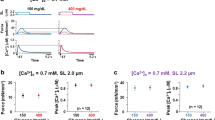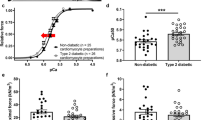Abstract
Diabetes mellitus is associated with an increased risk of heart failure, resulting from a specific cardiomyopathy independent of coronary atherosclerosis. It is not yet established whether altered myocardial function is related to changes in molecular mechanics of myosin. Accordingly, we investigated the total number, single force and kinetics of myosin crossbridges (CB) in a rat model of streptozotocin–induced diabetic cardiomyopathy. Experiments were conducted on left ventricular papillary muscles from male diabetic (D) Wistar (n = 16) and age–matched control (C) rats (n = 15). Mechanical indices including the maximum unloaded shortening velocity Vmax and the maximum total isometric tension normalized per cross–sectional area TFmax were determined. Using A. F. Huxley’s equations, we calculated the total cycling CB number per mm2 Ψ, the elementary force per single CB Π, the maximum values of the rate constant for CB attachment f1 and detachment g1 and g2, and the turnover rate of myosin ATPase per site kcat. The D rats exhibited a 25% decrease in TFmax and a 34% decrease in Vmax as compared to C. This contractile dysfunction was associated with a significant reduction in Ψ (9.0 ± 1.6 in D versus 11.4 ± 1.9 109mm–2 in C, P < 0.001) without significant change in Π (6.1 ± 0.8 in D versus 6.3 ± 0.9 pN in C, NS). In the 2 groups, TFmax correlated positively with Ψ (r = 0.76, P < 0.001 and r = 0.64, P < 0.01, in D and C respectively) but no relationship was found between TFmax and Π. As compared to C, D showed lower values of f1, g1 and g2, and a slower turnover rate of myosin ATPase. Thus, present data suggested that the cardiac contractile impairment observed in streptozotocin–induced diabetic rat cardiomyopathy was mainly related to a decrease in active CB total number and CB kinetics alterations without significant change in CB single force.
Similar content being viewed by others
References
Allo SN, Lincoln TM, Wilson GL, Green FJ, Watanabe AM, Schaffer SW (1991) Non insulin-dependent diabetes-induced defects in cardiac cellular calcium regulation. Am J Physiol 260 (Cell Physiol):C1165–C1171
Alpert NR, Mulieri LA (1982) Myocardial adaptation to stress from the viewpoint of evolution and development. In: Basic biology of muscles: a comparative approach. New York: Raven Press, pp 173–188
Coirault C, Lambert F, Joseph T, Blanc FX, Chemla D, Lecarpentier Y (1997) Developmental changes in crossbridge properties and myosin isoforms in hamster diaphragm. Am J Respir Crit Care Med 156:959–967
Coirault C, Lambert F, Marchand-Adam S, Attal P, Chemla D, Lecarpentier Y (1999) Myosin molecular motor dysfunction in dystrophic mouse diaphragm. Am J Physiol 277:C1170–C1176
Dhalla NS, Liu X, Panagia V, Takeda N (1998) Subcellular remodeling and heart dysfunction in chronic diabetes. Cardiovasc Res 40:239–247
Dillman WH (1980) Diabetes mellitus induces changes in cardiac myosin of the rat. Diabetes 29:579–582
Eisenberg E, Hill TL, Chen YD (1980) Cross-bridge model of muscle contraction: quantitative analysis. Biophys J 29:195–225
Factor SM, Minase T, Sonnenblick EH (1980) Clinical and morphological features of human hypertensive-diabetic cardiomyopathy. Am Heart J 99:446–458
Fein F, Sonnenblick EH (1985) Diabetic cardiomyopathy. Prog Cardiovasc Dis 27:255–270
Fein F, Sonnenblick EH (1994) Diabetic cardiomyopathy. Cardiovasc Drug Therap 8:65–73
Finer JT, Simmons RM, Spudich JA (1994) Single myosin molecule mechanics: piconewton forces and nanometre steps. Nature 368:113–119
Ganguly PK, Pierce GN, Dhalla KS, Dhalla NS (1983) Defective sarcoplasmic reticular calcium transport in diabetic cardiomyopathy. Am J Physiol 244 (Endocrinol Metab 7):E528–E535
Garber DW, Neely JR (1983) Decreased myocardial function and myosin ATPase in hearts from diabetic rats. Am J Physiol 244 (Heart Circ Physiol 13):H586–H591
Guilford WH, Dupuis DE, Kennedy G, Wu J, Patlak JB, Warshaw DM (1997) Smooth muscle and skeletal muscle myosins produce similar unitary forces and displacements in the laser trap. Biophys J 72:1006–102
Hamby RI, Zoneraich S, Sherman L (1974) Diabetic cardiomyopathy. JAMA 229:1749–1754
Hasenfuss G, Mulieri LA, Blanchard EM, Holubarsh C, Leavitt BJ, Ittleman F, Alpert NA (1991) Energetics of isometric tension development in control and volume- overload human myocardium. Comparison with animal species. Circ Res 68:836–846
Heyliger CE, Prakash A, McNeill JH (1987) Alterations in cardiac sarcolemmal Ca2+ pump activity during diabetes mellitus. Am J Physiol 252 (Heart Circ Physiol 21):H540–H547
Hill AV (1938) The heat of shortening and the dynamic constants of muscle. Proc R Soc Lond. Biol Sci 126:136–195
Huxley AF (1957) Muscle structure and theories of contraction. Prog Biophys Biophys Chem 7:255–318
Huxley HE (1969) The mechanism of muscular contraction. Science 194:1356– 1366
Huxley AF, Simmons RM (1971) Proposed mechanism of force generation in striated muscle. Nature 233:533–538
Joseph T, Coirault C, Lecarpentier Y (2000) Species-dependant changes in mechano-energetics of isolated cardiac muscle during hypoxia. Bas Res Cardiol 95:378–384
Kannel WB, Hjortland M, Gastelli WP (1974) Role of diabetes in congestive heart failure: the Framingham study. Am J Cardiol 134:29–34
Kita Y, Shimizu M, Sugihara N, Yoshio H, Shibayama S, Takeda R (1991) Correlation between histological changes and mechanical dysfunction in diabetic rat hearts. Diabetes Res Clin Pract 11:177–188
Kita Y, Shimizu M, Shibayama S, Yoshio H, Ino H, Mabuchi H (1991) Correlation between myocardial dysfunction and changes in myosin isoenzymes in diabetic rat hearts. J Diab Compl 10:38–42
Lambert F, Lecarpentier Y, Lompré AM, Scalbert E, Desché P, Chemla D (1995) Relations between myocardial contractility, myosin phenotype, and plasma angiotensin-converting enzyme activity in the cardiomyopathic hamster. J Cardiovasc Pharmacol 25:410–415
Lecarpentier Y, Bugaisky LB, Chemla D, Mercadier JJ, Schwartz K, Whalen RG, Martin JL (1987) Coordinated changes in contractility, energetics, and isomyosins after aortic stenosis. Am J Physiol 252:H275–H282
Lecarpentier Y, Coirault C, Lerebours G, Desche P, Scalbert E, Lambert F, Chemla D (1997) Effects of angiotensin-converting enzyme inhibition on crossbridge properties of diaphragm in cardiomyopathic hamsters of the dilated Bio 53-58 strain. Am J Respir Crit Care Med 155:630–636
Lecarpentier Y, Chemla D, Blanc FX, Pourny JC, Joseph T, Riou B, Coirault C (1998) Mechanics, energetics and crossbridge kinetics of rabbit diaphragm during congestive heart failure. FASEB J 12:981–989
Makino N, Dhalla KS, Elimban V, Dhalla NS (1987) Sarcolemmal Ca2+ transport in streptozotocin-induced diabetic cardiomyopathy in rats. Am J Physiol 253 (Endocrinol Metab 7):E202–E207
Malhotra A, Penpargkul S, Fein FS, Sonnenblick EH, Scheuer J (1981) The effect of streptozotocin-induced diabetes in rats on cardiac contractile proteins. Circ Res 49:1243–1250
Malhotra A, Sanghi V (1997) Regulation of contractile proteins in diabetic heart. Cardiovasc Res 34:41–47
Oh-Ishi M, Ueno T, Maeda T (2003) Protomic method detects oxidatively induced protein carbonyls in muscles of a diabetes model Otsuka Long-Evans Tokushima fatty (oleft) rat. Free Radic Biol Med 34:11–22
Palmiter KA, Tyska MJ, Dupuis DE, Alpert NR, Warshaw DM (1999) Kinetics differences at the single molecule level account for the functional diversity of rabbit cardiac myosin isoforms. J Physiol 519:669–678
Paradise NF, Schmitter JL, Surmitis JM (1981) Criteria for adequate oxygenation of isometric kitten papillary muscle. Am J Physiol 241:H348–H353
Penpargkul SP, Fein F, Sonnenblick EH, Scheuer Jl (1981) Depressed cardiac sarcoplasmic reticular function from diabetic rats. J Mol Cell Cardiol 13:303–309
Pierce GN, Dhalla NS (1981) Cardiac myofibrillar ATPase activity in diabetic rats. J Mol Cell Cardiol 13:1063–1069
Pierce GN, Russel JC (1997) Regulation of intracellular Ca2+ in the heart during diabetes. Cardiovasc Res 34:41–47
Rayment I, Ryniewsji WR, Schmidt-Base K, Smith R, Tomchick DR, Benning MM, Winkelmann DA, Wesenberg G, Holden HM (1993) Three-dimensional structure of myosin subfragment-1: a molecular motor. Science 261:50–58
Regan TJ, Lyons MM, Ahmed S, Levinson GE, Oldewurtel HA, Ahmad MR, Haider B (1977) Evidence for cardiomyopathy in familial diabetes mellitus. J Clin Invest 60:885–899
Rodrigues B, Cam MC, McNeill JH (1995) Myocardial substrate metabolism: implications for diabetic cardiomyopathy. J Mol Cell Cardiol 27:169–179
Rubler S, Dlugash J, Yuceoglu YZ, Kumral T, Branwood AW, Grishman A (1972) New type of cardiomyopathy associated with diabetic glomerulosclerosis. Am J Cardiol 30:595–602
Spudich JA (1994) How molecular motors work. Nature 372:515–518
Stanley WC, Lopaschuk GD, McCormack JG (1997) Regulation of energy substrate metabolism in the diabetic heart. Cardiovasc Res 34:25–33
Sugiura S, Kobayakawa N, Momomura S, Chaen S, Omata M, Sugi H (1996) Different cardiac myosin isoforms exhibit equal force-generating ability in vitro. Biochim Biophys Acta 1273:73–76
Sugiura S, Kobayakawa N, Fujita H, Yamashita H, Momomura S, Chaen S, Omata M, Sugi H (1998) Comparison of unitary displacements and forces between 2 cardiac myosin isoforms by the optical trap technique. Circ Res 82:1029– 1034
Sweeney HL, Holzbaur EL (1996) Mutational analysis of motor proteins. Annu Rev Physiol 58:751–792
Timsit J, Riou B, Bertherat J, Wisnewsky C, Kato NS, Weisberg AS, Lubetzki J, Lecarpentier Y, Winegrad S, Mercadier JJ (1990) Effects of chronic growth hormone hypersecretion on intrinsic contractility, energetics, isomyosin pattern, and myosin adenosine triphosphatase activity of rat left ventricle. J Clin Invest 86:507–515
Uyeda TQP, Ruppel KM, Spudich JA (1994) Enzymatic activities correlate with chimeric substitutions at the actin-binding face of myosin. Nature 368:567–568
Woledge RC, Curtin NA, Homsher E (1985) Energetic aspects of muscle contraction. Monogr Physiol Soc 41:27–117
Ye G, Metrveli NS, Ren J, Epstein PN (2003) Metallothionein prevents diabetes- induced deficits in cardiomyocytes by inhibiting reactive oxygen species production. Diabetes 52:777–783
Author information
Authors and Affiliations
Corresponding author
Rights and permissions
About this article
Cite this article
Joseph, T., Coirault, C., Dubourg, O. et al. Changes in crossbridge mechanical properties in diabetic rat cardiomyopathy. Basic Res Cardiol 100, 231–239 (2005). https://doi.org/10.1007/s00395-005-0512-5
Received:
Revised:
Accepted:
Published:
Issue Date:
DOI: https://doi.org/10.1007/s00395-005-0512-5




